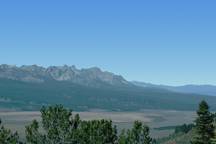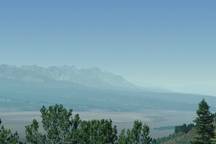Haze/Regional Haze
We all enjoy the breathtaking views of our national parks and scenic areas. In Idaho, hundreds of thousands of people visit Craters of the Moon, Hells Canyon, and the Sawtooth Wilderness area each year. However, visibility in these areas is threatened by air pollution, seen as haze, which obscures the pristine views we once enjoyed.


SawtoothWilderness Area
Haze impacts how far we can see and how clear the view appears.
Causes of Haze
Haze-causing pollutants include sulfur oxides, nitrogen oxides, particulates, and elemental and organic carbons. Some of these pollutants are found naturally in our air; others are created by human activity. Some haze-causing pollutants are directly emitted into the air; while others are formed when gases emitted into the air undergo a chemical reaction to form pollution.
Sources of haze-causing pollutants include emissions from on- and off-road vehicles, trains, agricultural equipment, and gas-powered lawn mowers, from smoke stacks at large industrial facilities and from smaller combined sources, and from natural sources such as volcanic emissions, windblown dust, and smoke from wildfires.
Haze-forming pollution can travel hundreds of miles. Regional haze in Idaho's natural parks and scenic areas is attributable to a variety of natural and human source of air pollution and is greatly impacted by climate. During the summer months, haze is often caused by smoke from fires caused by wildfires, prescribed burning, and agricultural burning. In the wintertime, particularly during inversions, sources include wood burning, vehicle exhaust, and local industrial emissions.
Impacts of Haze
Haze not only impacts visibility, but some haze-causing pollutants have been linked to serious health problems and environmental damage as well. Exposure to very small particles in the air can contribute to increased respiratory illness, decreased lung function, and even premature death. In addition, particles such as nitrates and sulfates contribute to acid rain formation, which makes lakes, rivers, and streams unsuitable for many fish, and erodes buildings, monuments, and paint on cars.
Haze also has an economic consequence. Each year, millions of visitors travel throughout the United States to our national parks and wilderness areas. Haze affecting these areas obscures the spectacular views they expect. Over time, this could lead to fewer visitors or shorter visits.
Federal Actions to Address Regional Haze
To address the aesthetic, public health, and economic impacts of haze, Congress amended the Clean Air Act in 1977 to establish national goals for visibility. The US Environmental Protection Agency (EPA) was tasked with developing regulations to remedy visibility impairment in 156 Class I areas. Class I areas include all national parks greater than 6,000 acres, wilderness areas and national memorial parks greater than 5,000 acres, and international parks that existed as of August 1977. Many of our best-known and most-treasured national parks, such as Grand Canyon, Mount Ranier, Shenandoah, Yellowstone, and Yosemite, are among the Class I areas. Idaho's Class I areas include the Sawtooth Wilderness Area, Craters of the Moon, Yellowstone National Park, Hells Canyon, and Selway-Bitterroot Wilderness Area.
in 1980, EPA issued the first phase of regulations to address haze-causing pollutants from large industrial facilities, such as coal-fired power plants. In 1990, Congress amended the Clean Air Act again and authorized further research and regional assessment reports on the issue of regional haze.
In 1999, EPA developed a regional haze program and regional haze rules. The Regional Haze Rule called for states to establish goals for improving visibility in national parks and wilderness areas and to develop long-term strategies for reducing emissions of air pollutants that cause visibility impairment in their own states and for preventing degradation in other states. The rule required states to establish goals for each affected Class I area and make reasonable progress toward (1) improving visibility on the haziest days and (2) ensuring no degradation occurs on the clearest days over the period of each implementation plan. Under the regional haze rule, states must take actions to address visibility in their own state, and to prevent degradation in other states.
Idaho's Regional Haze State Implementation Plan
In response the federal Regional Haze Rule, Idaho has developed an air quality protection plan to reduce haze-causing air pollution. Idaho’s Regional Haze State Implementation Plan identifies natural and man-made sources of haze in the state and provides strategies for reducing emissions that contribute to haze in the following three Class I areas: Craters of the Moon National Monument, Sawtooth Wilderness Area, and Selway-Bitterroot Wilderness Area. The document has been submitted to EPA for final review and inclusion in Idaho's Air Quality State Implementation Plan.
The document is divided into the following sections:
- Chapters 1–5 provide a basic overview of the regional haze basic planning elements, consultation through the Western Regional Air Partnership, monitoring and other technical tools relied upon to develop the plan, and an introduction to Idaho’s Class I areas.
- Chapters 6–9 provide information on Idaho’s emissions inventory, the pollutants causing visibility impairment in Idaho and surrounding states, and establishes baseline, natural conditions and a uniform rate of progress for each of Idaho’s Class I areas.
- Chapter 10 covers Idaho’s Best Available Retrofit Technology (BART) requirements and the determinations on the two BART-subject facilities—Amalgamated Sugar Company in Nampa and Monsanto/P4 in Soda Springs—that will be required to install control technologies within the next 5 years.
- Chapters 11 and 12 establish reasonable progress goals and long-term strategies for Idaho.
- Chapter 13 covers the formal consultation process and future requirements.
Link to the SIP and appendices below:
- Regional Haze Plan, Chapters 1–13
- Appendix A: Regional Haze Definitions
- Appendix B: SIP Development and Consultation
- Appendix C: Pollutants Causing Visibility Impairment
- Appendix D: Emission Inventory
- Appendix E: Source Apportionment
- Appendix F: Best Available Retrofit Technology
- Appendix G: Reasonable Progress Goals
- Appendix H: Long Term Strategies
- Appendix I: Future Commitments

